View in other NatureServe Network Field Guides
NatureServe
Montana
Utah
Wyoming
Idaho
Wisconsin
British Columbia
South Carolina
Yukon
California
New York
Western Branded Skipper - Hesperia colorado
Native Species
Global Rank:
G5
State Rank:
S5
Agency Status
USFWS:
USFS:
BLM:
External Links
General Description
There has been disagreement on the taxonomic status of Hesperia colorado (Western Branded Skipper), which has formally been considered a subspecies of H. comma (Common Branded Skipper) in some prior treatments and a full species in others (Scott 1975d, 1986; Layberry et al. 1998; Opler and Wright 1999; Glassberg 2001; Pyle 2002). In 2023 the taxonomy and distribution of these species was clarified and H. colorado is accepted as the species that occurs in Montana (Pelham 2023).
[From Ferris and Brown 1981; Scott 1986; Layberry et al. 1998; Opler and Wright 1999; Glassberg 2001; Pyle 2002] Forewing 1.3-1.6 cm. Highly variable. Antennae < 1/3 wing lenth with large clubs, forewing often pointed, fringe grayish to whitish and unchecked. Uppersurface orange to tawny to reddish, border dark and narrow to broad (depending on subspecies), not extending inward in a tooth-like pattern, forewing with whitish postmedian and apical spots, male forewing stigma with interior black felt; undersurface greenish or grayish to orange to chocolate-brown, postmedian spots of hindwing chevron large and silver-white to yellowish-white.
Phenology
One flight most areas (Shapiro and Forister 2005), two flights reported in southern Nevada (Austin and Austin 1980). Mid-June to mid-September in Canada (Layberry et al. 1998). Late June through August in Colorado (Brown 1957; Emmel 1964; Warren and Calhoun 2015), Mid-May to late October in Nevada (Austin and Austin 1980), mid-June to late September in California (Emmel and Emmel 1962; Shapiro 1977; Shapiro and Calhoun 2005), early May to late September in Oregon and Washington (Pyle 2002), mid-June to late September in Oregon (Warren 2005).
Diagnostic Characteristics
Uppersurface borders generally narrow and not extending inward in a tooth-like pattern, undersurface of hindwing gray-green with postmedian spots of chevron large and silver-white to yellowish-white.
Species Range
Montana Range
Range Descriptions

 Native
Native
Range Comments
Yukon and British Columbia east to the Atlantic coast, across the northern US-Canada border, Nebraska, south to northern Baja California, southeastern Arizona, southwestern New Mexico (Layberry et al. 1998; Opler and Wright 1999; Guppy and Shepard 2001; Pyle 2002; Shapiro and Forister 2005; Warren 2005; Warren and Calhoun 2015); to at least 3048 m elevation in the Rocky Mountain states (Ferris and Brown 1981), 2050 m to 3962 m elevation (possibly 4200 m) in Colorado (Brown 1957; Warren and Calhoun 2015), 1829 m to 3633 m in Nevada (Austin and Austin 1980), 850 m to at least 2743 m elevation in northern California (Emmel and Emmel 1962; Shapiro 1977; Shapiro and Forister 2005), 30 m to at least 2743 m elevation in Oregon (Warren 2005), to at least 2438 m elevation in Washington (Pyle 2002). In Montana, reported from at least 26 counties across the state, east to Custer and Carter counties (Kohler 1980; Stanford and Opler 1993; FLMNH Lepidopterists' Society database), about 610 m to (presumably) at least 3048 m elevation. Common to abundant in some localities (Glassberg 2001; Warren 2005).
Observations in Montana Natural Heritage Program Database
Number of Observations: 17
(Click on the following maps and charts to see full sized version)
Map Help and Descriptions
Relative Density
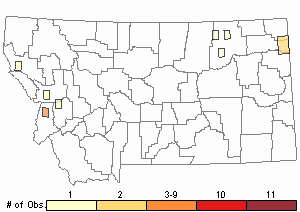
Recency
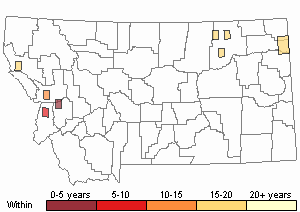
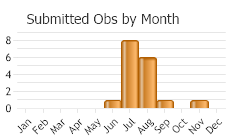
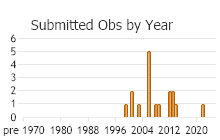
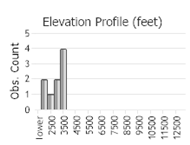 (Observations spanning multiple months or years are excluded from time charts)
(Observations spanning multiple months or years are excluded from time charts)
Migration
Non-migratory.
Habitat
Grasslands, open woodlands, brushlands, above treeline in alpine habitat (Ferris and Brown 1981; Scott 1986; Layberry et al. 1998; Opler and Wright 1999; Glassberg 2001; Pyle 2002). Habitat in Montana not described but probably similar.
Food Habits
Larval food plants are grasses, including Achnatherum, Andropogon, Anthoxanthum, Bromus, Bouteloua, Festuca, Lolium, Muhlenbergia, as well as Elytrigia, Poa, and Setaria in captivity; also sedges, including Carex (Scott 1986, 1992, 2006; Layberry et al. 1998; Pyle 2002; Shapiro and Forister 2005; James 2009; James and Nunnallee 2011). Adults feed on flower nectar (including Achillea, Apocynum, Arnica, Calyptridium, Chaenactis, Chrysothamnus, Cirsium, Erigeron, Grindelia, Haplopappus, Heterotheca, Hymenoxys, Liatris, Penstamon, Polygonum, Potentilla, Prunus, Sarcostema, Sedum, Solidago, Taraxacum) and mud (Austin and Austin 1980; Pyle 2002; Shapiro and Forister 2005; Warren 2005; Scott 2014; Gelling 2015).
Reproductive Characteristics
Females lay eggs singly and somewhat haphazardly on or near the base of host plant (Scott 1986, 1992, 2006; James and Nunnallee 2011). Eggs containing L1 instars (sometimes L1 instars) overwinter (depending on cohort), hatch in the wild 260-290 days after egg-laying (depending on temperature), hatch in captivity 45-65 days post egg-laying, develop to L5 or L6 instars in 63-97 days and undergo summer diapause (dormancy), pupate the following spring, adults eclose (emerge from pupae) in 14-18 days; egg to adult duration in wild 336-410 days, in captivity 64-80 days (Scott 1975e; James 2009; James and Nunnallee 2011). Larvae feed on host plant leaves, live in silk-tied leaf nests, develop though 6 instars, pupate within cocoon in last leaf nest (Scott 1975e, 1979; James 2009; James and Nunnallee 2011). Males perch throughout the day, often on hilltops, flat areas, along roadsides, awaiting passing females (Scott 1975b, 1986; Warren 2005; James and Numnnallee 2011).
References
- Literature Cited AboveLegend:
 View Online Publication
View Online Publication Acorn, J. and I. Sheldon. 2006. Butterflies of British Columbia. Edmonton, Alberta. Lone Pine Publishing. pp.360
Acorn, J. and I. Sheldon. 2006. Butterflies of British Columbia. Edmonton, Alberta. Lone Pine Publishing. pp.360 Austin, G.T. and A.T. Austin. 1980. Butterflies of Clark County, Nevada. Journal of Research on the Lepidoptera 19:1-63.
Austin, G.T. and A.T. Austin. 1980. Butterflies of Clark County, Nevada. Journal of Research on the Lepidoptera 19:1-63. Emmel, T.C. 1964. The ecology and distribution of butterflies in a montane community near Florissant, Colorado. American Midland Naturalist 72(2): 358-373.
Emmel, T.C. 1964. The ecology and distribution of butterflies in a montane community near Florissant, Colorado. American Midland Naturalist 72(2): 358-373. Emmel, T.C. and J.F. Emmel. 1962. Ecological studies of Rhopalocera in a High Sierran Community-Donner Pass, California. I. Butterfly associations and distributional factors. Journal of the Lepidopterists' Society 16:23-44.
Emmel, T.C. and J.F. Emmel. 1962. Ecological studies of Rhopalocera in a High Sierran Community-Donner Pass, California. I. Butterfly associations and distributional factors. Journal of the Lepidopterists' Society 16:23-44. Ferris, C.D. and F.M. Brown (eds). 1981. Butterflies of the Rocky Mountains. Univ. of Oklahoma Press. Norman. 442 pp.
Ferris, C.D. and F.M. Brown (eds). 1981. Butterflies of the Rocky Mountains. Univ. of Oklahoma Press. Norman. 442 pp. Gelling, L.L. 2015. Habitat associations of adult Oregon branded skipper, Hesperia colorado oregonia (W.H. Edwards, 1883)(Lepidoptera: Hesperiidae), at Cordova Shore, Vancouver Island, British Columbia. Journal of the Entomological Society of British Columbia 112:57-68.
Gelling, L.L. 2015. Habitat associations of adult Oregon branded skipper, Hesperia colorado oregonia (W.H. Edwards, 1883)(Lepidoptera: Hesperiidae), at Cordova Shore, Vancouver Island, British Columbia. Journal of the Entomological Society of British Columbia 112:57-68. Glassberg, J. 2001. Butterflies through Binoculars: A Field Guide to the Butterflies of Western North America. Oxford University Press.
Glassberg, J. 2001. Butterflies through Binoculars: A Field Guide to the Butterflies of Western North America. Oxford University Press. Guppy, C.S. and J.H. Shepard. 2001. Butterflies of British Columbia: including western Alberta, southern Yukon, the Alaska Panhandle, Washington, northern Oregon, northern Idaho, northwestern Montana. UBC Press (Vancouver, BC) and Royal British Columbia Museum (Victoria, BC). 414 pp.
Guppy, C.S. and J.H. Shepard. 2001. Butterflies of British Columbia: including western Alberta, southern Yukon, the Alaska Panhandle, Washington, northern Oregon, northern Idaho, northwestern Montana. UBC Press (Vancouver, BC) and Royal British Columbia Museum (Victoria, BC). 414 pp. James, D.G. 2009. Comparative studies on the immature stages and biology of Hesperia colorado idaho and Hesperia juba (Hesperiidae). Journal of the Lepidopterists' Society 63:129-136.
James, D.G. 2009. Comparative studies on the immature stages and biology of Hesperia colorado idaho and Hesperia juba (Hesperiidae). Journal of the Lepidopterists' Society 63:129-136. James, D.G. and D. Nunnallee. 2011. Life histories of Cascadia butterflies. Corvallis, OR: Oregon State University Press. 447 p.
James, D.G. and D. Nunnallee. 2011. Life histories of Cascadia butterflies. Corvallis, OR: Oregon State University Press. 447 p. Kohler, S. 1980. Checklist of Montana Butterflies (Rhopalocera). Journal of the Lepidopterists' Society 34(1): 1-19.
Kohler, S. 1980. Checklist of Montana Butterflies (Rhopalocera). Journal of the Lepidopterists' Society 34(1): 1-19. Layberry, R.A., P.W. Hall, and J.D. LaFontaine. 1998. The Butterflies of Canada. University of Toronto Press. 280 pp. + color plates.
Layberry, R.A., P.W. Hall, and J.D. LaFontaine. 1998. The Butterflies of Canada. University of Toronto Press. 280 pp. + color plates. Miskelly, J.W. 2009. Notes on the taxonomy and status of the genus Hesperia (Lepidoptera: hesperiidae) on Vancouver Island. Journal of the Entomological Society of British Columbia 106:83-84.
Miskelly, J.W. 2009. Notes on the taxonomy and status of the genus Hesperia (Lepidoptera: hesperiidae) on Vancouver Island. Journal of the Entomological Society of British Columbia 106:83-84. Opler, P.A. and A.B. Wright. 1999. A field guide to western butterflies. Second edition. Peterson Field Guides. Houghton Mifflin Company, Boston, Massachusetts. 540 pp.
Opler, P.A. and A.B. Wright. 1999. A field guide to western butterflies. Second edition. Peterson Field Guides. Houghton Mifflin Company, Boston, Massachusetts. 540 pp. Pyle, R.M. 2002. The butterflies of Cascadia: a field guide to all the species of Washington, Oregon, and surrounding territories. Seattle Audubon Society, Seattle, Washington. 420 pp.
Pyle, R.M. 2002. The butterflies of Cascadia: a field guide to all the species of Washington, Oregon, and surrounding territories. Seattle Audubon Society, Seattle, Washington. 420 pp. Scott, J.A. 1975b. Mate-locating behavior of western North American butterflies. Journal of Research on the Lepidoptera 14:1-40.
Scott, J.A. 1975b. Mate-locating behavior of western North American butterflies. Journal of Research on the Lepidoptera 14:1-40. Scott, J.A. 1975d. Clinal intergradation of Hesperia comma colorado (Hesperiidae). Journal of the Lepidopterists' Society 29:156-161.
Scott, J.A. 1975d. Clinal intergradation of Hesperia comma colorado (Hesperiidae). Journal of the Lepidopterists' Society 29:156-161. Scott, J.A. 1975e. Early stages of seven Colorado Hesperia (Hesperiidae). Journal of the Lepidopterists' Society 29:163-167.
Scott, J.A. 1975e. Early stages of seven Colorado Hesperia (Hesperiidae). Journal of the Lepidopterists' Society 29:163-167. Scott, J.A. 1979. Hibernal diapause of North American Papilionoidea and Hesperioidea. Journal of Research on the Lepidoptera 18(3): 171-200.
Scott, J.A. 1979. Hibernal diapause of North American Papilionoidea and Hesperioidea. Journal of Research on the Lepidoptera 18(3): 171-200. Scott, J.A. 1986. The butterflies of North America: a natural history and field guide. Stanford University Press, Stanford, California.
Scott, J.A. 1986. The butterflies of North America: a natural history and field guide. Stanford University Press, Stanford, California. Scott, J.A. 1992. Hostplant records for butterflies and skippers (mostly from Colorado) 1959-1992, with new life histories and notes on oviposition, immatures, and ecology. Papilio new series #6. 185 p.
Scott, J.A. 1992. Hostplant records for butterflies and skippers (mostly from Colorado) 1959-1992, with new life histories and notes on oviposition, immatures, and ecology. Papilio new series #6. 185 p. Scott, J.A. 2006. Butterfly hostplant records, 1992-2005, with a treatise on the evolution of Erynnis, and a note on new terminology for mate-locating behavior. Papilio new series #14. 74 p.
Scott, J.A. 2006. Butterfly hostplant records, 1992-2005, with a treatise on the evolution of Erynnis, and a note on new terminology for mate-locating behavior. Papilio new series #14. 74 p. Scott, J.A. 2014. Lepidoptera of North America 13. Flower visitation by Colorado butterflies (40,615 records) with a review of the literature on pollination of Colorado plants and butterfly attraction (Lepidoptera: Hersperioidea and Papilionoidea). Contributions of the C.P. Gillette Museum of Arthopod Diversity. Fort Collins, CO: Colorado State University. 190 p.
Scott, J.A. 2014. Lepidoptera of North America 13. Flower visitation by Colorado butterflies (40,615 records) with a review of the literature on pollination of Colorado plants and butterfly attraction (Lepidoptera: Hersperioidea and Papilionoidea). Contributions of the C.P. Gillette Museum of Arthopod Diversity. Fort Collins, CO: Colorado State University. 190 p. Scott, J.A. and M.S. Fisher. 1998. New western North American butterflies. Papilio new series #11. 10 p.
Scott, J.A. and M.S. Fisher. 1998. New western North American butterflies. Papilio new series #11. 10 p. Shapiro, A.M. 1977. The alpine butterflies of Castle Peak, Nevada County, California. Great Basin Naturalist 37(4): 443-452.
Shapiro, A.M. 1977. The alpine butterflies of Castle Peak, Nevada County, California. Great Basin Naturalist 37(4): 443-452. Shapiro, A.M. and M.L. Forister. 2005. Phenological 'races' of the Hesperia colorado complex (Hesperiidae) on the west slope of the California Sierra Nevada. Journal of the Lepidopterists' Society 59:161-165.
Shapiro, A.M. and M.L. Forister. 2005. Phenological 'races' of the Hesperia colorado complex (Hesperiidae) on the west slope of the California Sierra Nevada. Journal of the Lepidopterists' Society 59:161-165. Stanford, R.E. and P.A. Opler. 1993. Atlas of western USA butterflies: including adjacent parts of Canada and Mexico. Unpubl. Report. Denver and Fort Collins, Colorado 275 pp.
Stanford, R.E. and P.A. Opler. 1993. Atlas of western USA butterflies: including adjacent parts of Canada and Mexico. Unpubl. Report. Denver and Fort Collins, Colorado 275 pp. Threatful, D.L. 1988. A list of the butterflies and skippers of Mount Revelstoke and Glacier National Parks, British Columbia, Canada (Lepidoptera). Journal of Research on the Lepidoptera 27(3-4): 213-221.
Threatful, D.L. 1988. A list of the butterflies and skippers of Mount Revelstoke and Glacier National Parks, British Columbia, Canada (Lepidoptera). Journal of Research on the Lepidoptera 27(3-4): 213-221. Warren, A.D. 2005. Lepidoptera of North America 6: Butterflies of Oregon, their taxonomy, distribution, and biology. Contributions of the C. P. Gillette Museum of Arthropod Diversity, Colorado State University. Fort Collins, Colorado. 406 pp.
Warren, A.D. 2005. Lepidoptera of North America 6: Butterflies of Oregon, their taxonomy, distribution, and biology. Contributions of the C. P. Gillette Museum of Arthropod Diversity, Colorado State University. Fort Collins, Colorado. 406 pp. Warren, A.D. and J.V. Calhoun. 2015. A new name for alpine populations of Hesperia colorado (Scudder)(Hesperiidae: Hesperiinae) in Colorado. Journal of the Lepidopterists' Society 69:39-49.
Warren, A.D. and J.V. Calhoun. 2015. A new name for alpine populations of Hesperia colorado (Scudder)(Hesperiidae: Hesperiinae) in Colorado. Journal of the Lepidopterists' Society 69:39-49.
- Additional ReferencesLegend:
 View Online Publication
View Online Publication
Do you know of a citation we're missing? Allen, T.J., J.P. Brock, and J. Glassberg. 2005. Caterpillars in the field and garden: a field guide to the butterfly caterpillars of North America. Oxford University Press.
Allen, T.J., J.P. Brock, and J. Glassberg. 2005. Caterpillars in the field and garden: a field guide to the butterfly caterpillars of North America. Oxford University Press. Bailowitz, R.A. 1988. Census of the butterflies of the National Audubon Society Appleton-Whittell Research Ranch, Elgin, AZ. Journal of Research on the Lepidoptera. 27:120-128.
Bailowitz, R.A. 1988. Census of the butterflies of the National Audubon Society Appleton-Whittell Research Ranch, Elgin, AZ. Journal of Research on the Lepidoptera. 27:120-128. Brock, J.P. and K. Kaufman. 2003. Kaufman Field Guide to Butterflies of North America. Houghton Mifflin Company, New York, NY 284 pp.
Brock, J.P. and K. Kaufman. 2003. Kaufman Field Guide to Butterflies of North America. Houghton Mifflin Company, New York, NY 284 pp. Brown, F.M. 1957. Colorado Butterflies. Proceedings; Numbers Three through Seven. Denver Museum of Natural History, Denver, Co.
Brown, F.M. 1957. Colorado Butterflies. Proceedings; Numbers Three through Seven. Denver Museum of Natural History, Denver, Co. Forister, M.L., C.A. Halsch, C.C. Nice, J.A. Fordyce, T.E. Dilts, J.C. Oliver, K.L. Prudic, A.M. Shapiro, J.K. Wilson, J. Glassberg. 2021. Fewer butterflies seen by community scientists across the warming and drying landscapes of the American West. Science 371:1042-1045.
Forister, M.L., C.A. Halsch, C.C. Nice, J.A. Fordyce, T.E. Dilts, J.C. Oliver, K.L. Prudic, A.M. Shapiro, J.K. Wilson, J. Glassberg. 2021. Fewer butterflies seen by community scientists across the warming and drying landscapes of the American West. Science 371:1042-1045. Forister, M.L., E.M. Grames, C.A. Halsch, K.J. Burls, C.F. Carroll, K.L. Bell, J.P. Jahner, et al. 2023. Assessing risk for butterflies in the context of climate change, demographic uncertainty, and heterogeneous data sources. Ecological Monographs 93(3):e1584. https://doi.org/10.1002/ecm.1584
Forister, M.L., E.M. Grames, C.A. Halsch, K.J. Burls, C.F. Carroll, K.L. Bell, J.P. Jahner, et al. 2023. Assessing risk for butterflies in the context of climate change, demographic uncertainty, and heterogeneous data sources. Ecological Monographs 93(3):e1584. https://doi.org/10.1002/ecm.1584 Forister, M.L., J.A. Fordyce, and A.M. Shapiro. 2004. Geological barriers and restricted gene flow in the Holarctic skipper Hesperia comma (Hesperiidae). Molecular Ecology 13:3489-3499.
Forister, M.L., J.A. Fordyce, and A.M. Shapiro. 2004. Geological barriers and restricted gene flow in the Holarctic skipper Hesperia comma (Hesperiidae). Molecular Ecology 13:3489-3499. Fultz, J.E. 2005. Effects of shelterwood management on flower-visiting insects and their floral resources. M.Sc. Thesis. Bozeman, MT: Montana State University. 163 p.
Fultz, J.E. 2005. Effects of shelterwood management on flower-visiting insects and their floral resources. M.Sc. Thesis. Bozeman, MT: Montana State University. 163 p. Hendricks, P. and M. Roedel. 2001. A faunal survey of the Centennial Valley Sandhills, Beaverhead County, Montana. Report to the U.S. Bureau of Land Management and U.S. Fish and Wildlife Service. Montana Natural Heritage Program, Helena, MT. 44 p.
Hendricks, P. and M. Roedel. 2001. A faunal survey of the Centennial Valley Sandhills, Beaverhead County, Montana. Report to the U.S. Bureau of Land Management and U.S. Fish and Wildlife Service. Montana Natural Heritage Program, Helena, MT. 44 p. Sater, S. 2022. The insects of Sevenmile Creek, a pictorial guide to their diversity and ecology. Undergraduate Thesis. Helena, MT: Carroll College. 242 p.
Sater, S. 2022. The insects of Sevenmile Creek, a pictorial guide to their diversity and ecology. Undergraduate Thesis. Helena, MT: Carroll College. 242 p. Scott, J.A. and G.R. Scott. 1978. Ecology and distribution of the butterflies of southern central Colorado. Journal of Research on the Lepidoptera 17(2): 73-128.
Scott, J.A. and G.R. Scott. 1978. Ecology and distribution of the butterflies of southern central Colorado. Journal of Research on the Lepidoptera 17(2): 73-128. Scott, J.A. and M.E. Epstein. 1987. Factors affecting phenology in a temperate insect community. American Midland Naturalist 117(1): 103-118.
Scott, J.A. and M.E. Epstein. 1987. Factors affecting phenology in a temperate insect community. American Midland Naturalist 117(1): 103-118. Simanonok, M.P., and L.A. Burkle. 2014. Partitioning interaction turnover among alpine pollination networks: Spatial temporal, and environmental patterns. Ecosphere 5(11):149.
Simanonok, M.P., and L.A. Burkle. 2014. Partitioning interaction turnover among alpine pollination networks: Spatial temporal, and environmental patterns. Ecosphere 5(11):149.
- Web Search Engines for Articles on "Western Branded Skipper"
- Additional Sources of Information Related to "Insects"





